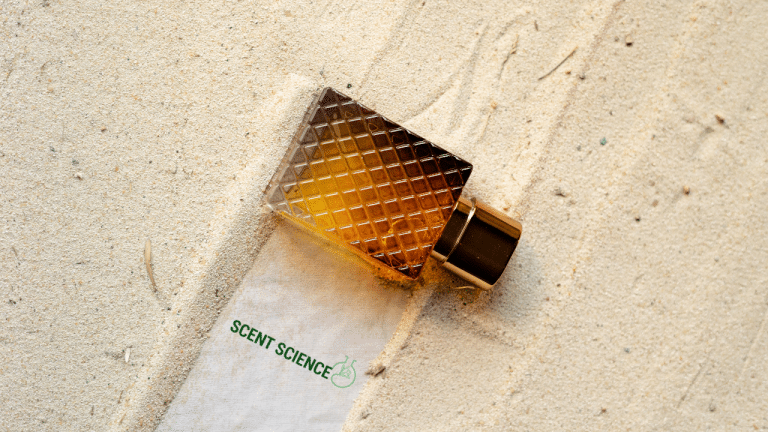Ever had a moment where you walked past someone, caught a whiff of their fragrance, and found yourself transported back to a cherished memory? Days at your grandma’s with baking pies, evenings with friends at a summer festival, or cozy winter nights by the fire. Fragrances have the power to linger in our minds and evoke vivid images from the past, and there’s a bit of science behind why certain scents hold the memory power they do.
So, how does a perfume continue to resonate even after hours? It’s all in the **perfume notes**—specifically, the base notes. Let’s demystify these invisible charmers that anchor a fragrance into our essence.
Table of Contents
ToggleThe Magic Behind Perfume Notes
Okay, let’s start at the beginning. Perfume is just as much about science as it is art. It’s a carefully crafted continuum of evaporation times and molecular weight. The basic structure that makes a perfume complex is the pyramid model composed of top notes, middle notes, and base notes.
A Quick Recap on the Structure
- Top Notes: These are your first impression, like the opening act in a concert. They’re light and breezy, usually citrusy or herbal, and they fade fairly quickly.
- Middle Notes (Heart Notes): These form the body and soul of the perfume. Once the top notes evaporate, these start to sing. Think florals, spices, and herbs.
- Base Notes: The **star of our show—our focused exploration today. Base notes stay with you, grounded in the background, influencing the fragrance’s personality as time wears on.
Science Meets Scent
When you spray perfume, a succession of notes start their aromatic dance. Due to their heavier molecular weight, base notes are the slowest to evaporate, which gives them the power to linger. Think of woody scents, amber, vanilla, and musks—yup, all base notes. They’re fundamentally what holds the fragrance’s true identity together.
And why should you care? Because a solid understanding of base notes can fortify your selection skills, helping you pick scents that echo your personal style.
The Technical Core: Diving into Base Notes

Now, let’s geek out a bit—don’t worry, this will be fun! Understanding the composition and influence of base notes isn’t just for chemists. Think of it as the foundation of a good perfume.
Why Base Notes Matter
Base notes aren’t a gimmick to sell more perfume. They’re crucial to the fragrance composition process. Here’s why:
- Longevity and Depth: Basic science fact—heavier molecules evaporate slower. Base notes ensure the scent doesn’t flee shortly after applying. They bind everything together, creating a lasting depth that continues to unfold over hours.
- Mood and Memory: Trust me, a perfume’s base notes are the reason you feel a cozy nostalgia or bold confidence. Their lingering nature keeps the memory loop active in your mind. Remember your uncle’s beloved old leather armchair smell? That’s a typical leather base note at work.
- Harmonizer: While middle notes are the beating heart, base notes are the backbone. They’re supremely skilled at lending stability to lighter notes, ensuring they all play nice.
Exploring Common Base Notes
Here’s a casual rundown of usual suspects on the base note front. These notes shape fragrances we carry into our personal spheres:
- Amber: Warm, neutral, and slightly spicy—a timeless crowd favorite.
- Musk: Not overtly dominant but sexual and suggestive in subtle waves.
- Patchouli: Earthy and pungent; it’s the grown-up call-back to your bohemian ideals.
- Sandalwood: Soft, woody, a bit creamy, vibing pure elegance.
- Vanilla: Sweet and comforting—a snuggly kitchen mid-afternoon smell.
Humans gravitate towards these notes due to their richness and the stability they imbue into the fragrance composition.
Decoding Complexity: How Base Notes Play Along
Circling back and mixing things up a bit, it’s important to grasp how base notes fit into the larger perfume creation process. Selection of base notes occur with intent. Perfume creators are maestros, blending ingredients that complement or contrast, building an intricate tapestry.
Step-by-step Understanding

Let’s breakdown how sense makers juggle these potency players:
- Conceptualization: Perfumers kick things off with a vision—often abstract. For instance, if the concept is “Midnight Forest,” base notes like cedarwood and vetiver might form the foundational track.
- Blending with Middle and Top Notes: Creating balance is key. Base notes shouldn’t overpower but bolster the other two. Sandalwood, with its mellow tones, will underline a lavender middle note effortlessly.
- Trial and Error: Timing, strength, and antecedents—fragrances require precise balance. Perfumers often adjust ratios, alter components and observe longevity before the ‘aha!’ moment clicks.
Bridging Science and Art
Crafting scents is as much a chemistry experience as it is an art show. It’s an academic treasure trove, bridging technical education with an almost historical artisan experience. Scholars should dive into how specific base notes chemically interact with top and middle notes, altering evaporation rates and influencing diffusion dynamics. There’s a whole world of technical knowledge grounded in perfume notes.
Making Scent Selections: Using Your Understandings
You’ve been an awesome participant in digging through base notes. Here’s a little guide to bottle up your knowledge in the real world!
Choose Your Signature Scent
You’re not simply following trends or cultures but carving out an odor persona. Here’s how understanding base notes empowers your choice-making:
- Burrow into What Resonates: Think back, which smells have lifted your spirits? A hint of warmth? Maybe amber or vanilla dominate your spaces more.
- Test Run: Use what you’ve learned to score samples before committing. Wear them through your day, while bouncing from morning buzz to evening ugg boot coziness.
- Adopt Variety: Knowledge is power. Mix and match; different occasions, moods, or seasons may demand a shift. That spicy musk could be ace for your late December getaway balcony occasions.
Trust Your Scent Instincts

Learning technical facets is only a piece of the puzzle. Listening to your personal inclinations holds equal sway. The interplay between technical insights and sheer preference often leads to unforgettable, tailored scent stories.
Common Mistakes to Avoid
You’re practically a base notes digital champ, but don’t jump the perfume lunges blindly. Let’s laser in on a few pitfalls to steer clear of:
- Forgetting Not All Perfumes are Created Equal: Concentration levels matter. Parfums possess higher levels of perfume oil (around 20-30%), ensuring base notes play their signature-staying act.
- Over-perfuming: Keep it understated—you’ll thank us later for this. Let your installed base notes do stylishly subtle work instead of announcing your presence beyond boundaries.
- Ignoring environment and use-case: Sunny beach brunch or sophisticated gala? Choose respective base heavyweights. Light musks might power up airy settings; while richer ambers melodicize when dressed up.
Bringing it All Home
Take a deep, satisfying breath. You’ve gone from the basics to honing in on the depth of perfume notes, specifically the beauty of the base variety. From evoking emotions out of nowhere to fueling personal memories, scents root deep within us thanks to these captivating molecules.
Always circle back to recall that science walks beautifully alongside this age-old craft. Perfume notes lay the foundational base of that journey—onward, inward, and inspiring every step along the way.
Trust yourself. It’s not merely about collecting bottles on a shelf, but creating a scent library that journeys with you, carrying stories in every whiff. So, next time you dab on essence from a flacon, hold a moment of appreciative introspection. You’re not just wearing fragrance; you’re unleashing an aromatic tale you’re crafting day by day.
Frequently Asked Questions
What are perfume notes?
Perfume notes are the individual scent layers of ingredients that make up a fragrance. They are categorized into three main types: top notes, heart notes (or middle notes), and base notes. These notes contribute to the overall scent profile and development of a fragrance over time[1][3][5>.
What are the different types of perfume notes and how do they function?
Top notes are the light, volatile scents perceived immediately after applying a perfume. They are often fresh, citrusy, or sharp and evaporate quickly. Heart notes, or middle notes, emerge after the top notes fade and form the main body of the fragrance, typically lasting from 20 minutes to an hour. Base notes are the rich, long-lasting scents that appear after the heart notes and provide depth and solidity to the fragrance, often lasting for several hours or even days[1][3][5>.
How can I identify the different perfume notes in a fragrance?
You can identify perfume notes based on the time elapsed after applying the perfume. Top notes are the scents you smell immediately, heart notes emerge as the top notes fade, and base notes become apparent after about 30 minutes and last the longest. Each note category has distinct characteristics, such as fresh and citrusy for top notes, floral and spicy for heart notes, and rich and woody for base notes[1][3][5>.
What are some common examples of each type of perfume note?
Common top notes include citrus elements like bergamot, lemon, and orange zest, as well as light fruits and fresh herbs. Heart notes often feature scents like rose, ylang ylang, and cinnamon. Base notes typically include rich scents such as vanilla, amber, musk, patchouli, and woody notes like sandalwood and cedarwood[1][3][5>.
References







